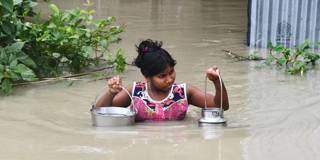The droughts, floods, and severe weather that come with climate change will leave the world's poorest and most vulnerable even worse off, overwhelming today's system of humanitarian aid. Only by strengthening poor people's climate resilience can they meet the coming challenges.
LONDON – As preparations for this year’s COP26 climate summit in Glasgow intensify, attention is focused on efforts to prevent a future catastrophe. But real-time climate catastrophes already are playing out in the lives of millions of the world’s poorest and most vulnerable people. What will COP26 offer them?
Stick a pin in a map of global humanitarian emergencies, and you will most likely land on a crisis that has been caused or aggravated by droughts, floods, and storms. In 2019, extreme weather events pushed more than 34 million people into hunger and food insecurity. In the 55 countries with food-insecurity crises, 75 million children under the age of five are chronically undernourished and face higher risks of diarrhea, pneumonia, and other killer diseases that accompany droughts and floods.
Save the Children is responding to these emergencies. In the Horn of Africa, our nutrition programs are treating the children of farming families devastated by successive droughts, floods, and the worst desert locust infestation in a generation. In the Sahel region, we are working with communities hit by drought and displaced by increasingly deadly conflicts over water. But humanitarian efforts are being overwhelmed by the scale of the crisis – and worse is to come.

LONDON – As preparations for this year’s COP26 climate summit in Glasgow intensify, attention is focused on efforts to prevent a future catastrophe. But real-time climate catastrophes already are playing out in the lives of millions of the world’s poorest and most vulnerable people. What will COP26 offer them?
Stick a pin in a map of global humanitarian emergencies, and you will most likely land on a crisis that has been caused or aggravated by droughts, floods, and storms. In 2019, extreme weather events pushed more than 34 million people into hunger and food insecurity. In the 55 countries with food-insecurity crises, 75 million children under the age of five are chronically undernourished and face higher risks of diarrhea, pneumonia, and other killer diseases that accompany droughts and floods.
Save the Children is responding to these emergencies. In the Horn of Africa, our nutrition programs are treating the children of farming families devastated by successive droughts, floods, and the worst desert locust infestation in a generation. In the Sahel region, we are working with communities hit by drought and displaced by increasingly deadly conflicts over water. But humanitarian efforts are being overwhelmed by the scale of the crisis – and worse is to come.